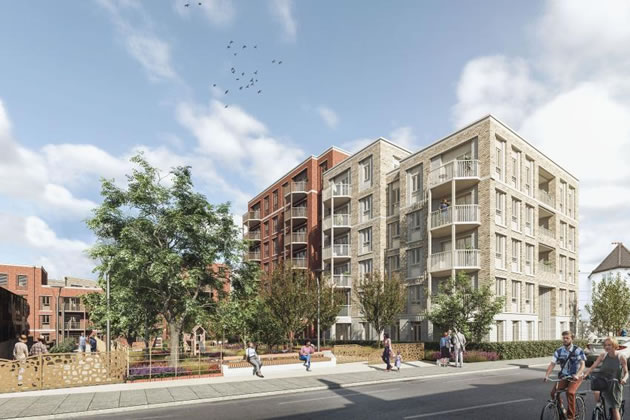Council Seeks to Boost Number of Family Homes
Says policy shift response to 'acute' demand in the borough

Less than 10% of the new flats Hartopp Point and Lannoy Point have more than two bedrooms. Picture: H&F Council
July 17, 2025
Hammersmith and Fulham Council is looking to boost the number of family homes in the borough in a bid to address what it has described as ‘acute’ demand.
The local authority’s Cabinet on Monday night (14 July) agreed seven actions to reverse the decline of such accommodation, with a focus on delivering for families on the housing register in-need of genuinely affordable three-bed homes.
An officer report detailed how as of March 2025 there were 907 households, 313 of which were homeless, on the register needing a three-bed home.
The actions fall under three broader areas; updating housing strategy and planning policy, making best use of existing homes, and building and buying new homes.
Hammersmith and Fulham Council has committed to ensuring 3,000 new homes are built or underway by 2026, 65 per cent of which will be affordable.
The local authority currently has around 2,500 households on its housing register, more than 75 per cent needing a two-bed property or larger.
In the Cabinet paper, officers wrote, “This demand is largely due to the unaffordability of market homes for low-income individuals and families, the needs of some residents requiring social housing support, as well as the attractiveness of the borough in relation to strong employment and lifestyle opportunities.
“Only with an ongoing supply of good-quality affordable homes can the borough realise its ambitions of vibrant, community-led placemaking and inclusive economic growth.”
The seven actions listed in the report include ensuring family accommodation features strongly in the new housing strategy, developing options to launch a campaign promoting downsizing to free up family homes, working with housing association partners to deliver more larger properties, and undertaking a scoping exercise to identify sites which can host family housing development opportunities.
Beneath each action further details are listed on what they will entail, from building and buying new family homes to what incentives may be introduced to encourage people to downsize.
Introducing the strategy, Cllr Frances Umeh, Cabinet Member for Housing and Homelessness, said: “It’s vital not only for meeting housing need, but also for sustaining school enrolment, supporting local services and ensuring that the borough remains a place where families can grow and thrive.”
Conservative councillor Adronie Alford, a regular at Cabinet meetings, acknowledged it is “absolutely essential” more family housing is delivered, though added she hopes the local authority will not “go mad” purchasing homes and so pushing up prices.
Cllr Rowan Ree, Cabinet Member for Finance and Reform, gave Cllr Alford such an assurance, with Cllr Umeh also responding, “The really important thing here is we address the overwhelming demand and need for family housing. Nearly a third of households that are on the housing register require a house that’s three bedrooms or more, [over] 900 people. This is a significant number so we need to take action.”
Leader of the council Stephen Cowan later reiterated the scale of the housing challenge the local authority faces and the “terrible” impacts on those growing up in temporary accommodation.
He however added the national Labour Government has “hit the ground running on this issue”, which he said would lead to significant change in the years to come.
Hammersmith and Fulham Council agreed last November to establish its own housing company to tackle issues including growing temporary accommodation pressures.
The new company will not be a developer like Croydon Council’s failed Brick by Brick venture, but will instead purchase and refurbish existing properties, enabling more homes to be either let out at intermediate rent, sold at a low-cost or used for temporary accommodation.
The lack of family homes completed in the capital in 2023/24 was highlighted in an article by The Londoner last year.
The publication found London’s housing market was dramatically skewed towards one and two-bed properties, with just two per cent of homes or flats having four or more bedrooms. The average across England was 26 per cent for the year, according to Government data.
The percentage of three-bed homes completed meanwhile was just 10 per cent, against a country-wide 37 per cent average.
Ben Lynch - Local Democracy Reporter